Eupatorium cannabinum
| Eupatorium cannabinum | |
|---|---|
.jpg) | |
| Scientific classification | |
| Kingdom: | Plantae |
| (unranked): | Angiosperms |
| (unranked): | Eudicots |
| (unranked): | Asterids |
| Order: | Asterales |
| Family: | Asteraceae |
| Tribe: | Eupatorieae |
| Genus: | Eupatorium |
| Species: | E. cannabinum |
| Binomial name | |
| Eupatorium cannabinum L. | |
Eupatorium cannabinum, commonly known as hemp-agrimony,[1] is a herbaceous plant of the family Asteraceae. It is a robust perennial native to many areas of Europe.[2] It is occasionally found as a garden escape in other areas such as British Columbia.[3]
If the genus Eupatorium is defined in a restricted sense (about 42 species), E. cannabinum is the only species of that genus native to Europe (with the remainder in Asia or North America).[4]
Description
E. cannabinum grows to 1.5 meters (4.9 feet) tall or more and 1.2 meters (3.9 feet) wide.[2] It lives in moist low-lying areas in temperate Eurasia. It is dioecious, with racemes of mauve flowers which are pollinated by insects from July to early September. The flowers are tiny, fluffy and can be pale dusty pink or whitish.[2] The fruit is an achene about 2 or 3 mm long, borne by a pappus with hairs 3 to 5 mm long, which is distributed by the wind. The plant over-winters as a hemicryptophyte.


Toxicity
Eupatorium cannabinum contains tumorigenic pyrrolizidine alkaloids.[5]
Subspecies
- Eupatorium cannabinum L. subsp. cannabinum
- Eupatorium cannabinum L. subsp. corsicum (Req. ex Loisel.) P.Fourn.
References
- ↑ "BSBI List 2007" (xls). Botanical Society of Britain and Ireland. Archived from the original on 2015-02-25. Retrieved 2014-10-17.
- ↑ 2.0 2.1 2.2 "Botanica. The Illustrated AZ of over 10000 garden plants and how to cultivate them", p 359. Könemann, 2004. ISBN 3-8331-1253-0
- ↑ "Eupatorium cannabinum". Flora of North America.
- ↑ Schmidt, Gregory J. & Schilling, Edward E. (2000): Phylogeny and biogeography of Eupatorium (Asteraceae: Eupatorieae) based on nuclear ITS sequence data. Am. J. Bot. 87(5): 716-726. doi:10.2307/2656858 PMID 10811796 PDF fulltext
- ↑ Fu, P.P., Yang, Y.C., Xia, Q., Chou, M.C., Cui, Y.Y., Lin G., "Pyrrolizidine alkaloids-tumorigenic components in Chinese herbal medicines and dietary supplements", Journal of Food and Drug Analysis, Vol. 10, No. 4, 2002, pp. 198-211
| Wikimedia Commons has media related to Eupatorium cannabinum. |